2. 福建省连江县水产技术推广站, 福建 连江 350500;
3. 上海海洋大学 农业农村部鱼类营养与环境生态研究中心, 上海 201306;
4. 上海海洋大学 水产科学国家级实验教学示范中心, 上海 201306
中华绒螯蟹(Eriocheir sinensis)是我国重要的淡水养殖蟹类,野生群体广泛分布于我国沿海各大水系,主要包括辽河、黄河、长江和瓯江等[1-3]。由于过度捕捞、水利设施影响河蟹洄游通道和环境污染等原因,河蟹野生资源急剧下降,难以满足市场需求[4]。在市场需求推动下,河蟹人工养殖在我国大部分地区迅速发展,2018年养殖产量达75.7万t [5]。目前,我国河蟹养殖区域主要集中在长江、黄河和辽河流域,主要养殖长江水系和辽河水系的河蟹[6-8]。河蟹可食率和营养组成的研究报道主要集中在长江水系养殖河蟹[9-10],有关其他水系河蟹成体的可食率和营养组成研究较少,迄今尚未见闽江水系绒螯蟹可食率和营养组成的报道。
近年来的调研表明,闽江水系存在较大的野生绒螯蟹群体,部分个体较大,具有一定的经济价值和研究价值。闽江水系绒螯蟹属的分类尽管存在较大争议[11-13],但是该群体具有一定的经济价值,且已在闽江流域进行人工养殖[5]。闽江水系绒螯蟹作为一种重要的种质资源,尚未见其繁殖性能、养殖性能和营养品质的研究报道,这非常不利于其开发利用和遗传选育。肌肉、性腺和肝胰腺是河蟹主要的可食用部位,所以出肉率、性腺指数、肝胰腺指数和总可食率是评价蟹类食用价值的重要指标[14-15]。经济蟹类可食部位的营养组成是影响其营养品质和经济价值的重要因素,营养组成主要包括常规生化成分、脂肪酸和氨基酸等[7-8, 14],且不同水系甲壳动物群体营养组成和含量可能有所不同,这可能与遗传和生长环境有关[7-8, 15-17],所以研究闽江水系野生河蟹的可食率及营养品质,对于该水系野生河蟹种质资源评价和开发利用具有一定的现实意义。鉴于此,笔者测定了闽江水系野生绒螯蟹的性腺指数、肝胰腺指数、出肉率、总可食率及可食部位中的常规生化组成、脂肪酸和氨基酸组成,并比较了雌雄间的性别差异,旨在为闽江水系野生绒螯蟹种质资源评估和开发利用等提供基础资料。
1 材料与方法 1.1 实验样本实验所用的闽江流域野生河蟹于2016年11月6日由福建省福州市连江县当地渔民在敖江流域捕捞所得,随机挑选雌雄河蟹各15只,活体运输至上海海洋大学甲壳动物营养繁殖实验室。用干毛巾擦干河蟹体表水分后,用电子天平称量其体质量(精确度=0.01 g)。活体解剖所有个体,取出全部肝胰腺和性腺并准确称量,用于计算肝胰腺指数(hepatosomatic index, HSI)和性腺指数(gonadosomatic index, GSI)。河蟹躯体经冷冻处理后,精刮出一半肌肉,准确称量后,用于计算出肉率(meat yield, MY)和总可食率(total edible yield, TEY)。肝胰腺、性腺和肌肉样品于-40 ℃保存用于后续营养成分测定。HSI、GSI、MY和TEY采用以下公式进行计算。
 (1)
(1)
 (2)
(2)
 (3)
(3)
 (4)
(4)
式中:HSI为肝胰腺指数;GSI为性腺指数;MY为出肉率,%;TEX为总可食率;WH表示肝胰腺质量,g;WG表示性腺质量,g;WM表示肌肉质量,g;W0表示体质量,g。
1.2 常规营养成分测定河蟹样品中水分含量采用冷冻干燥法进行测定[18],蛋白质含量采用凯氏定氮法进行测定[19];参考FOLCH等[20]的方法,采用V(氯仿): V(甲醇)=2: 1提取样品中脂肪并测定其含量;采用TCA提取样品中的碳水化合物[21],采用苯酚-硫酸法测定样品中的碳水化合物的含量[22]。
1.3 脂肪酸组成分析根据MORRISON等[23]的方法,采用14%三氟化硼-甲醇溶液(体积分数)对脂肪样品进行甲脂化处理,采用Agilent 7890B-5977A气相色谱-质谱联用仪(GC-MS)进行脂肪酸分析。色谱柱为Omegawax 320毛细管柱(30 m × 0.25 mm × 0.25 μm; Supelco, Billefonte, PA, USA),进样口温度为240 ℃,辅助加热器温度为245 ℃。升温程序:由40 ℃以10 ℃/min速率升至170 ℃,再以2 ℃/min速率升至220 ℃,保持1 min,最后以2 ℃/min速率升至230 ℃,直到所有脂肪酸全部出峰。采用峰面积归一化法对脂肪酸进行定量。
1.4 氨基酸含量测定采用盐酸水解法[24]测定每个样品中的异亮氨酸(Ile)、亮氨酸(Leu)、赖氨酸(Lys)、苯丙氨酸(Phe)、酪氨酸(Tyr)、苏氨酸(Thr)、缬氨酸(Val)、天冬氨酸(Asp)、丝氨酸(Ser)、谷氨酸(Glu)、甘氨酸(Gly)、丙氨酸(Ala)、组氨酸(His)、精氨酸(Arg)和脯氨酸(Pro)含量;采用碱水解法[25]测定每个样品中的色氨酸(Trp)含量;采用过甲酸氧化水解法[26]测定每个样品中的甲硫氨酸(Met)和半胱氨酸(Cys)含量。按照FAO/WHO/UNU[27]的方法对必需氨基酸进行评分,必需氨基酸分值(essential amino acid score, EAAS)为样品中必需氨基酸含量与FAO参考蛋白中必需氨基酸含量比值乘以100,其中FAO参考蛋白中必需氨基酸含量主要依据学龄前(2~5岁)儿童的必需氨基酸需求量确定。
1.5 数据处理采用SPSS 19.0软件数据进行统计分析,数据以平均值±标准差(Mean ± SD)表示。采用Levene法进行方差齐性检验,当数据不满足齐性方差时对百分比数据进行反正弦或者平方根处理,用独立样本t检验进行显著性分析,P < 0.05为差异显著,P < 0.01为差异极显著。
2 结果与分析 2.1 组织系数和总可食率由表 1可知:雄蟹体质量和MY均极显著大于雌蟹(P < 0.01),雌蟹的GSI极显著高于雄蟹(P < 0.01);雌雄河蟹个体间的HSI和TEY均无显著性差异(P>0.05)。

|
表 1 闽江水系野生河蟹雌体和雄体组织系数和可食率比较 Tab.1 Comparison of tissue indices and total edible yield between female and male Eriocheir sensu stricto from Minjiang River |
由表 2可知:雄蟹性腺水分含量极显著高于雌蟹,雌蟹的脂肪、蛋白质含量和碳水化合物含量高于雄蟹(P < 0.01);雌蟹肝胰腺水分含量显著低于雄蟹(P < 0.05);雌蟹肝胰腺脂肪含量显著高于雄蟹(P < 0.05),雌雄蟹肝胰腺中的蛋白质含量和碳水化合物含量无显著差异(P>0.05);雌蟹和雄蟹肌肉中水分、脂肪、蛋白质和碳水化合物含量均无显著性差异(P>0.05)。
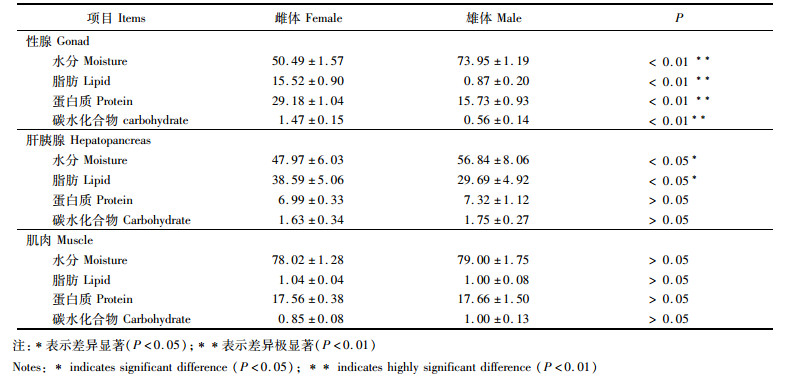
|
表 2 闽江河蟹雌体和雄体可食部位常规生化成分比较(%湿重) Tab.2 Comparison of proximate compositions in edible parts between female and male Eriocheir sensu stricto from Minjiang River (% wet weight, n=5) |
雌蟹和雄蟹肝胰腺中的主要饱和脂肪酸(SFA)为C14: 0、C16: 0和C18: 0,且两者肝胰腺中SFA和总饱和脂肪酸(∑SFA)含量均无显著性差异(P>0.05);在单不饱和脂肪酸(MUFA)中,主要的MUFA为C16: 1n7、C18: 1n7和C18: 1n9,雌蟹和雄蟹肝胰腺MUFA中除C14: 1n5和C22: 1n9含量存在显著差异外(P < 0.01),其余的MUFA和∑MUFA含量均无显著性差异(P>0.05);就多不饱和脂肪酸(PUFA)而言,肝胰腺中主要的PUFA为C18: 2n6、C20: 2n6和C20: 4n6,雌蟹和雄蟹肝胰腺中PUFA、∑PUFA、∑HUFA、∑n-3PUFA、∑n-6PUFA和n-3/n-6PUFA含量均无显著性差异(P>0.05)。见表 3。
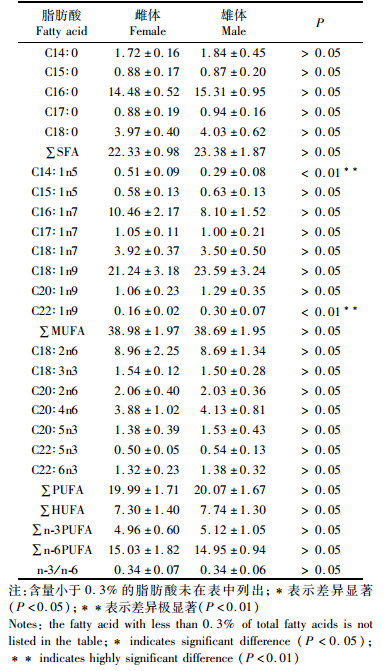
|
表 3 闽江河蟹雌体和雄体肝胰腺中脂肪酸含量的比较(%总脂肪酸) Tab.3 Comparison of fatty acid contents in hepatopancreas between female and male Eriocheir sensu stricto from Minjiang River (% total fatty acid, n=5) |
雌蟹性腺中的C14: 0、C15: 0和C16: 0含量均显著高于雄蟹,但雄蟹C18: 0、C20: 0和C22: 0含量均显著高于雌蟹(P < 0.01),雌蟹和雄蟹性腺中的∑SFA含量无显著性差异(P>0.05)。雌蟹性腺中的C15: 1n5、C16: 1n7、C17: 1n7、C18: 1n7、C18: 1n9和∑MUFA含量均极显著高于雄蟹(P < 0.01),C20: 1n9显著高于雄蟹(P < 0.05),C22: 1n9低于雄蟹且差异极显著(P < 0.01);在性腺PUFA中,雌体C18: 2n6、C18: 3n3显著高于雄体(P < 0.05),雄体C20: 2n6、C20: 4n6、C20: 5n3、C22: 6n3、∑PUFA、∑HUFA和∑n-6PUFA极显著高于雌体(P < 0.01),雄体和雌体C22: 5n3、∑n-3PUFA和n-3/n-6PUFA含量无显著性差异(P>0.05)。见表 4。
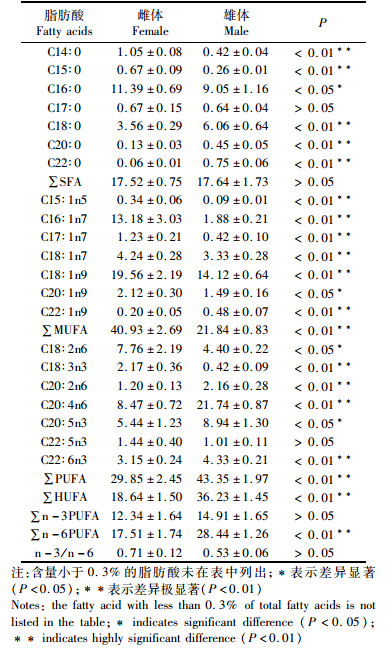
|
表 4 闽江河蟹雌体和雄体性腺中脂肪酸含量的比较(%总脂肪酸) Tab.4 Comparison of fatty acid contents in gonad between female and male Eriocheir sensu stricto from Minjiang River (% total fatty acid, n=5) |
闽江河蟹雌体和雄体肌肉中各SFA和∑SFA均无显著差异(P>0.05)。雌蟹肌肉中C16: 1n7、C17: 1n7、C18: 1n7和∑MUFA显著高于雄蟹(P < 0.05),雌蟹和雄蟹肌肉中C18: 1n9和C20: 1n9无显著差异(P>0.05);肌肉PUFA中,雌蟹的C18: 3n3含量显著高于雄蟹,雄蟹的C20: 4n6、∑PUFA、∑HUFA和∑n-6PUFA含量显著高于雌体(P < 0.05),其他PUFA无显著差异(P>0.05)。见表 5。
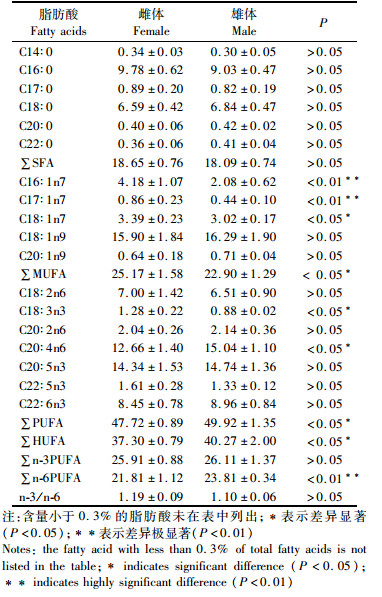
|
表 5 闽江河蟹雌体和雄体肌肉中脂肪酸含量的比较(%总脂肪酸) Tab.5 Comparison of fatty acids contents in muscle between female and male Eriocheir sensu stricto from Minjiang River (% total fatty acids, n=5) |
就必需氨基酸(essential amino acid, EAA)而言,雌蟹和雄蟹性腺中的半胱氨酸含量无显著性差异(P>0.05),但其余EAA和总必需氨基酸(∑EAA)含量均以雌蟹较高(P < 0.05)。就非必需氨基酸(non-essential amino acid, NEAA)而言,雌蟹性腺中的天冬氨酸、丝氨酸、谷氨酸、甘氨酸、丙氨酸和精氨酸含量极显著高于雄蟹,雄蟹脯氨酸含量极显著高于雌蟹(P < 0.01),两者性腺中的组氨酸含量无显著性差异(P>0.05)。雌蟹性腺中的TAA含量及∑EAA/TAA比例极显著高于雄蟹(P < 0.01)。见表 6。
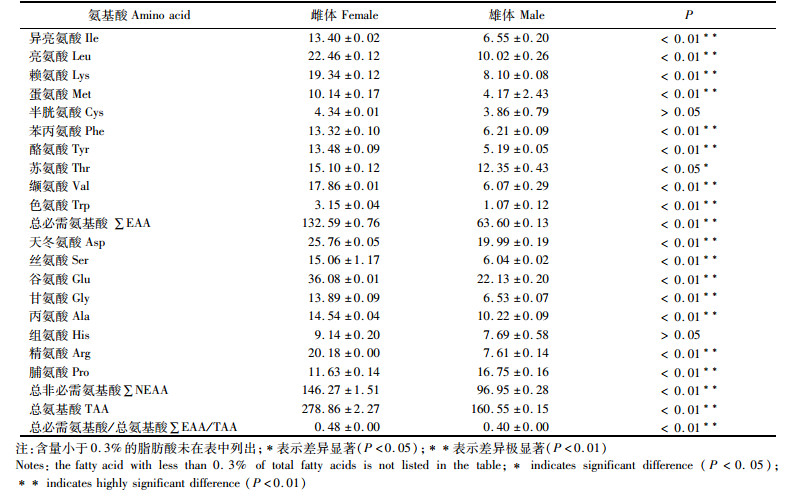
|
表 6 闽江河蟹雌体和雄体性腺中氨基酸含量的比较(mg/g湿重) Tab.6 Comparison of amino acid contents in gonad between female and male Eriocheir sensu stricto from Minjiang River (mg/g wet weight, n=5) |
雌蟹与雄蟹肌肉中半胱氨酸和色氨酸含量均较低,雄蟹肌肉中半胱氨酸含量显著高于雌蟹(P < 0.05),其他氨基酸含量和∑EAA含量较雌蟹无显著差异(P>0.05)。就NEAA而言,雌蟹与雄蟹肌肉中各氨基酸含量无显著性差异(P>0.05),雌蟹∑NEAA、TAA含量和∑EAA/TAA比值均略高于雄蟹,但均无显著性差异(P>0.05)。见表 7。
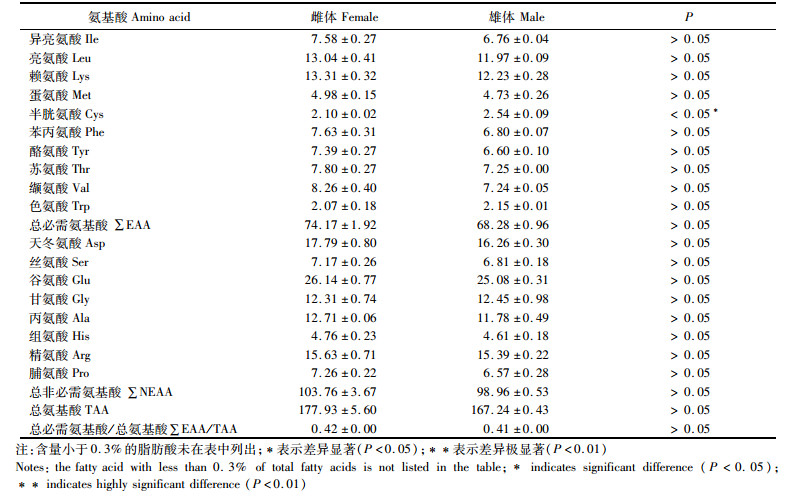
|
表 7 闽江河蟹雌体和雄体肌肉中氨基酸含量的比较(mg/g湿重) Tab.7 Comparison of amino acid contents in muscle between female and male Eriocheir sensu stricto from Minjiang River (mg/g wet weight, n=5) |
由表 8可知:雌蟹肌肉中大部分EAAS高于雄蟹且雌蟹EAAS的平均值高于雄蟹;就性腺而言,雌体除了苏氨酸和蛋氨酸+半胱氨酸的EAAS低于雄体外,其他氨基酸的EAAS均高于雄体,而且雌体色氨酸是其限制性氨基酸,雄体亮氨酸、赖氨酸和色氨酸是其限制性氨基酸。

|
表 8 闽江河蟹雌体和雄体性腺和肌肉的必需氨基酸评分的比较 Tab.8 Comparison of essential amino acid score of gonad and muscle between female and male Eriocheir sensu stricto from Minjiang River |
性腺是河蟹的重要可食组织,性腺发育状况直接影响蟹类的食用价值,性腺指数(GSI)通常是评价性腺发育情况的重要指标之一[28]。本研究发现闽江水系河蟹雌体的GSI显著高于雄体,这与滕炜鸣等[29]和吴旭干等[15]的研究结果一致,其原因可能是雌体需要在卵巢中积累大量的营养物质(如蛋白、脂肪和碳水化合物等)以确保产卵后的胚胎发育[30-31]。闽江水系河蟹雄体的体质量及出肉率显著高于雌体,与莱茵河蟹群体和长江河蟹群体的研究结果[29]相一致,说明肌肉是雄蟹可食部位的主要贡献者,雌雄河蟹的生物学特性存在差异,雄体的大螯明显大于雌体,这可能是其体质量高于雌体及出肉率较高的一个重要原因。此外,雄蟹的性腺指数小于雌蟹,可能导致雄蟹的肌肉所占体质量的百分比间接提高。
马明君[32]研究了长江水系野生河蟹10月底雌雄体性腺指数、出肉率和总可食率,与本研究中11月份闽江野生河蟹雌雄体性腺指数、出肉率和总可食率相接近,分析其原因为两地理种群的野生河蟹发育程度相似,所以种群间组织系数差异较小;此外,可能这两个种群遗传距离较近,所以差异较小,这有待进一步研究证明。所以,闽江水系河蟹具有经济价值,河蟹的可食部位比例具有性别差异。
3.2 闽江河蟹雌体和雄体可食部位常规生化组成的比较研究表明,闽江水系河蟹雌体性腺中的脂肪、蛋白质和碳水化合物含量均显著高于雄体,主要是由于河蟹雌雄个体生殖系统组成及其营养成分存在明显的性别差异[14, 28, 33],雌蟹和雄蟹在繁殖过程中发挥着不同的作用,雌蟹性腺会积累大量的营养物质[30, 34],为后续胚胎发育提供足够的营养物质。肝胰腺是蟹类营养物质(尤其是脂类)储备的主要组织[35-36],甲壳动物肝胰腺可为机体正常代谢和卵巢的发育提供能量来源[37]。研究发现,闽江水系河蟹雌体肝胰腺中的总脂含量显著高于雄体,可能雌蟹在产卵、抱卵孵化过程中需要消耗大量的以甘油三酯为主的脂类来提供足够的能量以保证产卵和孵化的顺利完成[38]。研究表明,虾蟹类的生化组成可能与其遗传和生长环境等因素有关[7-8, 15-17]。闽江水系河蟹雌雄个体肌肉中的水分、总脂、粗蛋白和总碳水化合物均无显著性差异,说明闽江水系河蟹肌肉的常规生化成分较为保守。综上,闽江水系河蟹雌体的性腺较雄体具有更高的食用和营养价值。
3.3 闽江河蟹雌体和雄体可食部位脂肪酸和氨基酸组成的比较蟹类可食组织中的脂肪酸组成和含量是评价其营养价值的重要指标[14, 35]。WU等[39]研究表明,河蟹肝胰腺的脂肪酸组成更容易受到饵料脂肪酸组成的影响。闽江水系河蟹雌体与雄体肝胰腺中的脂肪酸组成和含量较为接近,无显著性差异,这可能是由于闽江河蟹雌雄个体均来自同一水系,其食物组成相似,因此两者肝胰腺中的脂肪酸组成及含量较为接近。雌体性腺总饱和脂肪酸(∑SFA)和总单不饱和脂肪酸(∑MUFA)显著高于雄体,总多不饱和脂肪酸(∑PUFA)和总高度不饱和脂肪酸(∑HUFA)显著低于雄体,这可能与雌雄个体性腺发育过程中主要积累的脂肪酸不同有关。甲壳动物卵巢发育过程中主要积累能量型脂肪酸,以满足繁殖过程中胚胎发育的需求[40-41],而雄体性腺主要积累ARA、EPA和DHA等脂肪酸,以维持其正常的生理功能[14, 36]。就肌肉而言,闽江水系河蟹雌体肌肉的∑MUFA显著高于雄体,雄体肌肉的∑PUFA、∑HUFA和∑n-6PUFA含量显著高于雌蟹,因为蟹类肌肉的高度不饱和脂肪酸组成相对保守以维持肌肉的正常生理功能[35-36, 42],所以闽江河蟹雌体与雄体肌肉脂肪酸的差异可能与其生物学特性有关。食品中评价脂肪酸营养价值的重要指标有n-3/n-6和HUFA组成及含量等,食品中足量、平衡的MUFA和n-3HUFA对人体健康非常重要[35, 43-44]。闽江河蟹肌肉、肝胰腺和性腺中n-3/n-6均大于0.3,∑MUFA含量均高于∑SFA,所以闽江河蟹可食部位有较高的脂肪酸营养价值。肌肉和性腺中PUFA、HUFA和n-3/n-6均高于肝胰腺,SFA低于肝胰腺,说明闽江水系河蟹肌肉和性腺的脂肪酸营养价值高于肝胰腺。
蟹类可食组织中的氨基酸组成和含量是评价其营养价值的重要指标[8, 14]。闽江水系河蟹雌体性腺中的大部分氨基酸及总氨基酸含量均显著高于雄体,雄体性腺中脯氨酸含量显著高于雌体,这与蓝蟹(Portunus pelagicus)的研究结果[35]相一致。雌体性腺中较高氨基酸含量可能与雌体性腺发育中较高的粗蛋白等营养物质有关,这有利于后续胚胎的发育[30, 34],雄体性腺中较高的脯氨酸含量可能是为了保障其正常的生殖生理功能[45]。闽江水系河蟹雌雄个体肌肉中的氨基酸组成和含量无明显差异,说明闽江水系河蟹肌肉中氨基酸组成和含量相对保守,不存在性别差异。必需氨基酸/总氨基酸(EAA/TAA)和必需氨基酸评分(EAAS)是评价氨基酸营养价值的重要指标,EAA/TAA理想比值应为0.4左右,EAAS越高说明该氨基酸的营养价值越高,某种必需氨基酸的EAAS小于100说明该氨基酸是限制性氨基酸[24]。闽江水系河蟹雌雄体性腺和肌肉的EAA/TAA值均在0.4左右,雌体性腺EAA/TAA值显著高于雄体,表明闽江水系河蟹性腺和肌肉具有较高的必需氨基酸营养价值,雌体性腺必需氨基酸营养价值高于雄体;EAAS结果表明雌体性腺和肌肉的平均EAAS均高于雄体,雄体性腺的限制性氨基酸多于雌体,雌体的必需氨基酸营养价值高于雄体。
闽江水系野生河蟹的总可食率在40%左右,雄蟹的出肉率高于雌蟹,性腺指数低于雌蟹;雌蟹性腺中的粗蛋白、总脂和碳水化合物含量高于雄蟹;雄蟹性腺和肌肉中的多不饱和脂肪酸和高度不饱和脂酸含量高于雌蟹,雌雄河蟹的必需氨基酸组成合理,色氨酸为雌雄河蟹性腺的限制性氨基酸。整体上,闽江成蟹具有较高的营养价值和食用价值。
| [1] |
许加武, 任明荣, 李思发. 长江、辽河、瓯江中华绒螯蟹种群的形态判别[J]. 水产学报, 1997, 21(3): 269-274. XU J W, REN M R, LI S F. Morphological identification of population of Eriocheir sinensis from Changjiang, Liaohe and Oujiang Rivers[J]. Journal of Fisheries of China, 1997, 21(3): 269-274. |
| [2] |
SUI L Y, ZHANG F M, WANG X M, et al. Genetic diversity and population structure of the Chinese mitten crab Eriocheir sinensis in its native range[J]. Marine Biology, 2009, 156(8): 1573-1583. DOI:10.1007/s00227-009-1193-2 |
| [3] |
刘青, 刘皓, 吴旭干, 等. 长江、黄河和辽河水系中华绒螯蟹野生和养殖群体遗传变异的微卫星分析[J]. 海洋与湖沼, 2015, 46(4): 958-968. LIU Q, LIU H, WU X G, et al. Genetic variation of wild and cultured populations of Chinese mitten crab Eriocheir sinensis from the Yangtze, Huanghe, and Liaohe River basins using microsatellite marker[J]. Oceanologia et Limnologia Sinica, 2015, 46(4): 958-968. DOI:10.11693/hyhz20150400129 |
| [4] |
CHENG Y X, WU X G, YANG X Z, et al. Current trends in hatchery techniques and stock enhancement for Chinese mitten crab, Eriocheir japonica sinensis[J]. Reviews in Fisheries Science, 2008, 16(1/3): 377-384. |
| [5] |
农业农村部渔业渔政管理局. 2019年中国渔业统计年鉴[M]. 北京: 中国农业出版社, 2019: 44. Fisheries Fishery Administration, Ministry of Agriculture and Rural Affairs. China fishery statistical yearbook:2019[M]. Beijing: China Agriculture Press, 2019: 44. |
| [6] |
王武, 王成辉, 马旭洲. 河蟹生态养殖[M]. 北京: 中国农业出版社, 2013: 59-84. WANG W, WANG C H, MA X Z. Ecological culture of Chinese mitten crab aquaculture[M]. Beijing: China Agriculture Press, 2013: 59-84. |
| [7] |
赵恒亮, 吴旭干, 姜晓东, 等. 池塘养殖条件下长江、黄河和辽河种群中华绒螯蟹雌体卵巢发育和营养组成的比较研究[J]. 水产学报, 2017, 41(1): 109-122. ZHAO H L, WU X G, JIANG X D, et al. Comparative study on gonadal development and nutritional composition among Yangtze, Huang, and Liao River populations of adult female Eriocheir sinensis cultured in earth ponds[J]. Journal of Fisheries of China, 2017, 41(1): 109-122. |
| [8] |
赵恒亮, 吴旭干, 龙晓文, 等. 长江、黄河和辽河种群中华绒螯蟹雄体成蟹可食组织营养组成的比较[J]. 中国水产科学, 2016, 23(5): 1117-1129. ZHAO H L, WU X G, LONG X W, et al. Nutritional composition of cultured adult male Eriocheir sinensis from Yangtze River, Yellow River and Liaohe River[J]. Journal of Fishery Sciences of China, 2016, 23(5): 1117-1129. |
| [9] |
何杰, 吴旭干, 龙晓文, 等. 长江水系中华绒螯蟹野生和养殖群体选育子一代养殖性能和性腺发育的比较[J]. 海洋与湖沼, 2015, 46(4): 808-818. HE J, WU X G, LONG X W, et al. Culture performance and gonadal development of the first generation of selectively-bred Chinese mitten crabs from wild and cultured populations[J]. Oceanologia et Limnologia Sinica, 2015, 46(4): 808-818. |
| [10] |
何杰, 吴旭干, 龙晓文, 等. 池塘养殖和野生长江水系中华绒螯蟹扣蟹形态学及生化组成的比较研究[J]. 水产学报, 2015, 39(11): 1665-1678. HE J, WU X G, LONG X W, et al. Comparative studies of morphology and biochemical composition between wild-caught and pond-reared juvenile Chinese mitten crab for Yangtze population[J]. Journal of Fisheries of China, 2015, 39(11): 1665-1678. |
| [11] |
TANG B P, ZHOU K Y, SONG D X, et al. Molecular systematics of the Asian mitten crabs, genus Eriocheir (Crustacea:Brachyura)[J]. Molecular Phylogenetics and Evolution, 2003, 29(2): 309-316. DOI:10.1016/S1055-7903(03)00112-X |
| [12] |
XU J W, CHU K H. Genome scan of the mitten crab Eriocheir sensu stricto in East Asia:population differentiation, hybridization and adaptive speciation[J]. Molecular Phylogenetics and Evolution, 2012, 64(1): 118-129. DOI:10.1016/j.ympev.2012.03.009 |
| [13] |
CHU K H, HO H Y, LI C P, et al. Molecular phylogenetics of the mitten crab species in Eriocheir, sensu lato(Brachyura:Grapsidae)[J]. Journal of Crustacean Biology, 2003, 23(3): 738-746. DOI:10.1651/C-2347 |
| [14] |
WU X G, CHENG Y X, SUI L Y, et al. Biochemical composition of pond-reared and lake-stocked Chinese mitten crab Eriocheir sinensis(H. Milne-Edwards) broodstock[J]. Aquaculture Research, 2007, 38(14): 1459-1467. DOI:10.1111/j.1365-2109.2007.01728.x |
| [15] |
吴旭干, 龙晓文, 刘乃更, 等. 中华绒螯蟹、日本绒螯蟹及其杂交种性腺发育和生化组成的比较[J]. 淡水渔业, 2015, 45(3): 3-8. WU X G, LONG X W, LIU N G, et al. Comparative study on gonadal development and biochemical composition among Eriocheir sinensis, E. japonica and their hybrids[J]. Freshwater Fisheries, 2015, 45(3): 3-8. DOI:10.3969/j.issn.1000-6907.2015.03.001 |
| [16] |
田娟, 许巧情, 田罗, 等. 洞庭湖克氏原螯虾肌肉成分分析及品质特性分析[J]. 水生生物学报, 2017, 41(4): 870-877. TIAN J, XU Q Q, TIAN L, et al. The muscle composition analysis and flesh quality of Procambarus clarkia in the Dongting Lake[J]. Acta Hydrobiologica Sinica, 2017, 41(4): 870-877. |
| [17] |
卢义, 吴旭干, 何杰, 等. 长江、黄河、辽河水系中华绒螯蟹野生扣蟹的形态学及生化组成[J]. 中国水产科学, 2016, 23(2): 382-395. LU Y, WU X G, HE J, et al. Comparative studies of the morphology and biochemical composition of wild juvenile Chinese mitten crabs from the Yangtze River, Yellow River and Liaohe River systems[J]. Journal of Fishery Sciences of China, 2016, 23(2): 382-395. |
| [18] |
周加义, 叶慧. 冷冻干燥法和烘箱法测定肌肉中水分及对粗蛋白、粗脂肪测定的影响[J]. 中国家禽, 2017, 39(11): 51-53. ZHOU J Y, YE H. Freeze-drying method and oven method for determining muscle moisture and the influence on determining crude protein, crude fat[J]. China Poultry, 2017, 39(11): 51-53. |
| [19] |
AOAC. Official methods of analysis of the association of official analytical chemists[M]. 16th ed. Arlington, VA, USA: Association of Official Analytical Chemists, 1995.
|
| [20] |
FOLCH J, LEES M, SLOANE STANLEY G H. A simple method for the isolation and purification of total lipides from animal tissues[J]. Journal of Biological Chemistry, 1957, 226(1): 497-509. |
| [21] |
HOLLAND D L, GABBOTT P A. A micro-analytical scheme for the determination of protein, carbohydrate, lipid and RNA levels in marine invertebrate larvae[J]. Journal of the Marine Biological Association of the United Kingdom, 1971, 51(3): 659-668. DOI:10.1017/S0025315400015034 |
| [22] |
KOCHERT A G. Carbohydrate determination by the phenol-sulfuric acid method[M]//HELLEBUST J A, CRAIGIE J S. Handbook of Phycolocical Methods: Physiological and Biochemical Methods. London, Cambridge, UK: Cambridge University Press, 1978: 95-97.
|
| [23] |
MORRISON W R, SMITH L M. Preparation of fatty acid methyl esters and dimethylacetals from lipids with boron fluoride-methanol[J]. Journal of Lipid Research, 1964, 5: 600-608. |
| [24] |
CHEN D W, ZHANG M, SHRESTHA S. Compositional characteristics and nutritional quality of Chinese mitten crab (Eriocheir sinensis)[J]. Food Chemistry, 2007, 103(4): 1343-1349. DOI:10.1016/j.foodchem.2006.10.047 |
| [25] |
MATHESON N A. The determinatio of tryptophan in purified proteins and in feeding-stuffs[J]. British Journal of Nutrition, 1974, 31(3): 393-400. DOI:10.1079/BJN19740047 |
| [26] |
SPINDLER M, STADLER R, TANNER H. Amino acid analysis of feedstuffs:determination of methionine and cystine after oxidation with performic acid and hydrolysis[J]. Journal of Agricultural and Food Chemistry, 1984, 32(6): 1366-1371. DOI:10.1021/jf00126a038 |
| [27] |
FAO/WHO/UNU. Energy and protein requirements: report of a Joint FAO/WHO/UNU expert consultation. World Health Organization technical report series 724[R]. Geneva: WHO, 1985.
|
| [28] |
WU X G, LIU M M, PAN J, et al. The ovarian development pattern of pond-reared Chinese mitten crab, Eriocheir sinensis H. Milne-Edwards, 1853[J]. Crustaceana, 2017, 90(4): 449-470. DOI:10.1163/15685403-00003662 |
| [29] |
滕炜鸣, 成永旭, 吴旭干, 等. 莱茵种群和长江种群子一代中华绒螯蟹性腺发育及相关生物学指数变化的比较[J]. 上海水产大学学报, 2008, 17(1): 65-71. TENG W M, CHENG Y X, WU X G, et al. A comparative study on some biological index changes concerned with gonad development between two population of the Chinese mitten crab (Eriocheir sinensis):rhine and Yangtze[J]. Journal of Shanghai Fisheries University, 2008, 17(1): 65-71. |
| [30] |
LIU Z J, WU X G, CHENG Y X, et al. Ovarian re-maturation following the first spawning in the Chinese mitten crab, Eriocheir sinensis(H. Milne-Edwards)[J]. Aquaculture Research, 2011, 42(3): 417-426. DOI:10.1111/j.1365-2109.2010.02636.x |
| [31] |
LI S G, CHENG Y X, ZHOU B, et al. Changes in biochemical composition of newly spawned eggs, prehatching embryos and newly hatched larvae of the blue crab Callinectes sapidus[J]. Journal of Shellfish Research, 2012, 31(4): 941-946. DOI:10.2983/035.031.0405 |
| [32] |
马明君.不同蜕壳阶段和投喂模式下中华绒螯蟹营养成分的比较研究[D].上海: 上海海洋大学, 2015. MA M J. Comparison of nutritional component of molting stages and feeding modes Chinese mitten crab (Eriocheir sinensis)[D]. Shanghai: Shanghai Ocean University, 2015. |
| [33] |
徐佳倩, 吴旭干, 张鹏超, 等. 池塘养殖中华绒螯蟹二龄雄体生长、性腺发育和第二性征的变化[J]. 动物学杂志, 2016, 51(3): 434-448. XU J Q, WU X G, ZHANG P C, et al. Growth, gonadal development and secondary sexual characteristics of pond-reared male Chinese mitten crab (Eriocheir sinensis) during the second year culture[J]. Chinese Journal of Zoology, 2016, 51(3): 434-448. |
| [34] |
何杰, 吴旭干, 赵恒亮, 等. 全程投喂配合饲料条件下池养中华绒螯蟹的生长性能及其性腺发育[J]. 中国水产科学, 2016, 23(3): 606-618. HE J, WU X G, ZHAO H L, et al. Growth performance and gonadal development of pond-reared Chinese mitten crab (Eriocheir sinensis) fed formulated diets during the whole culture process[J]. Journal of Fishery Sciences of China, 2016, 23(3): 606-618. |
| [35] |
WU X G, ZHOU B, CHENG Y X, et al. Comparison of gender differences in biochemical composition and nutritional value of various edible parts of the blue swimmer crab[J]. Journal of Food Composition and Analysis, 2010, 23(2): 154-159. DOI:10.1016/j.jfca.2009.08.007 |
| [36] |
赵磊, 龙晓文, 吴旭干, 等. 混合植物油替代鱼油对中华绒螯蟹成体雄蟹常规成分和脂肪酸组成的影响[J]. 动物学杂志, 2016, 51(6): 1071-1083. ZHAO L, LONG X W, WU X G, et al. Effects of fish oil replacement by blending vegetable oils in fattening diets on proximate composition and fatty acid composition of adult male Chinese mitten crab (Eriocheir sinensis)[J]. Chinese Journal of Zoology, 2016, 51(6): 1071-1083. |
| [37] |
成永旭, 赖伟, 堵南山. 十足类甲壳动物卵巢发育过程中脂肪的积累与肝胰腺脂肪的变化[J]. 动物学杂志, 1997, 32(2): 57-60. CHENG Y X, LAI W, DU N S. Accumulation of lipid and changes of lipid in hepatopancreas during ovary development of decapitous crustaceans[J]. Chinese Journal of Zoology, 1997, 32(2): 57-60. |
| [38] |
成永旭, 堵南山, 赖伟. 不同阶段中华绒螯蟹肝胰腺的脂类及脂肪酸组成[J]. 动物学报, 1998, 44(4): 420-429. CHENG Y X, DU N S, LAI W. Lipid composition in hepatopancreas of Chinese mitten crab Eriocheir sinensis at different stages[J]. Acta Zoologica Sinica, 1998, 44(4): 420-429. DOI:10.3321/j.issn:0001-7302.1998.04.007 |
| [39] |
WU X G, WANG Z K, CHENG Y X, et al. Effects of dietary phospholipids and highly unsaturated fatty acids on the precocity, survival, growth and hepatic lipid composition of juvenile Chinese mitten crab, Eriocheir sinensis(H. Milne-Edwards)[J]. Aquaculture Research, 2011, 42(3): 457-468. DOI:10.1111/j.1365-2109.2010.02643.x |
| [40] |
吴旭干, 姚桂桂, 杨筱珍, 等. 东海三疣梭子蟹第一次卵巢发育规律的研究[J]. 海洋学报, 2007, 29(4): 120-127. WU X G, YAO G G, YANG X Z, et al. A study on the ovarian development of Portunus trituberculatus in East China Sea during the first reproductive cycle[J]. Acta Oceanologica Sinica, 2007, 29(4): 120-127. DOI:10.3321/j.issn:0253-4193.2007.04.014 |
| [41] |
吴旭干, 汪倩, 楼宝, 等. 育肥时间对三疣梭子蟹卵巢发育和营养品质的影响[J]. 水产学报, 2014, 38(2): 170-182. WU X G, WANG Q, LOU B, et al. Effects of fattening period on ovarian development and nutritional quality of female swimming crab (Portunus trituberculatus)[J]. Journal of Fisheries of China, 2014, 38(2): 170-182. |
| [42] |
常国亮, 吴旭干, 成永旭, 等. 不同脂类营养对中华绒螯蟹(Eriocheir sinensis)幼蟹生长、成活、肝胰腺指数和生化成分的影响[J]. 海洋与湖沼, 2008, 39(3): 276-283. CHANG G L, WU X G, CHENG Y X, et al. Effect of lipid nutrition on hepatosomatic index and biochemical composition of juvenile Eriocheir sinensis[J]. Oceanologia et Limnologia Sinica, 2008, 39(3): 276-283. DOI:10.3321/j.issn:0029-814X.2008.03.014 |
| [43] |
孙远明. 食品营养学[M]. 北京: 科学出版社, 2006: 65. SUN Y M. Food nutrition[M]. Beijing: Science Press, 2006: 65. |
| [44] |
FAO/WHO. Fats and oils in human nutrition: report of a joint expert consultation[M]. Rome: Food and Agriculture Organization of the United Nations, 1994.
|
| [45] |
麻楠, 龙晓文, 吴旭干, 等. 中华绒螯蟹成熟雄体生殖系统的生化组成分析[J]. 上海海洋大学学报, 2017, 26(6): 872-879. MA N, LONG X W, WU X G, et al. Biochemical composition in the reproductive system of the mature male Chinese mitten crab, Eriocheir sinensis[J]. Journal of Shanghai Ocean University, 2017, 26(6): 872-879. |
2. Lianjiang Fisheries Extension Station of Fujian Province, Lianjiang 350500, Fujian, China;
3. Centre for Research on Environmental Ecology and Fish Nutrition, Ministry of Agriculture and Rural Affairs, Shanghai Ocean University, Shanghai 201306, China;
4. National Demonstration Centre for Experimental Fisheries Science Education, Shanghai Ocean University, Shanghai 201306, China
 2019,
Vol. 28
2019,
Vol. 28


